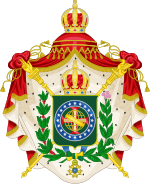President of the Council of Ministers of Brazil
| Prime Minister of Empire of Brazil | |
|---|---|

|
|
|
The Viscount of Rio Branco, the most successful and longest serving officeholder
|
|
| Residence | Rio de Janeiro, Empire of Brazil |
| Appointer | Emperor of Brazil (1847–1889) |
| Formation | 22 August 1847 |
| First holder | The 2nd Viscount of Caravelas |
| Final holder | The Viscount of Ouro Preto |
| Abolished | 15 November 1889 |
| Prime Minister of Brazil | |
|---|---|

|
|
|
Tancredo Neves, the longest serving officeholder in the Republic
|
|
| Residence | Brasília, Brazil |
| Appointer | President of Brazil (1961–1963) |
| Formation | 7 September 1961 |
| First holder | Tancredo Neves |
| Final holder | Hermes Lima |
| Abolished | 23 January 1963 |
The political position of Prime Minister of Brazil existed for two times. The first during the era of the Empire of Brazil, in which Brazil as a Constitutional Monarchy and became a Parliamentary monarchy. The office was created in 1847 and abolished together with the monarchy in 1889. The second time was in the 1960s when the presidential Brazil adopted the parliamentarist system lasting for less than 2 years. Officially, the title of the Prime Minister was President of the Council of Ministers both in the Empire and the Republic, and he was referred to by the press and the people as President of the Cabinet in the imperial era or Premier in the republican times.
The political position of Prime Minister of Brazil was first being created in 1847 by the brazilian Emperor Pedro II officially as President of the Council of Ministers, but he was referred to by the press and the people as President of the Cabinet. Often, the title President of the Council, a shortened version of the official style, was also employed.
The written Constitution of the Brazilian Empire did not require the Emperor to appoint a prime minister; nor did it provide for a parliamentary system of government, instead vesting the Executive authority in the Emperor himself, and stipulating that the Emperor was to be aided by ministers that he was free to appoint and dismiss. However, Emperor Pedro II decided to appoint a president of the Council among his ministers, to lead the workings of the Government. He also chose to create a sort of parliamentary government, whereby the prime minister would be someone who could command a majority in the Chamber of Deputies, the lower House of the Brazilian Imperial Parliament, known as General Assembly. Therefore, even without being required by the Constitution, the Emperor started to exercise his authority in a manner compatible with parliamentary government, only appointing as prime minister someone who could retain parliamentary support, etc.
However, the emperor didn't become a figurehead monarch like other heads of State in a parliamentary system. The prime minister needed to retain the political confidence both of a majority of the Chamber of Deputies and of the Emperor, who actively scrutinized the workings of the Government. Sometimes the Emperor would dissolve the Chamber of Deputies and summon new elections (a power he possessed under the Constitution), or dismiss the prime minister, due to his own political beliefs about the efficiency of the Government. Thus, the Emperor would often dismiss a prime minister, and then appoint someone else from the same party. All this led to a succession of short-lived Cabinets. The emperor retained decision-making powers with regard to the signature or veto of bills passed by Parliament, and would not always abide by the advice of his ministers. And that was seen as normal given that the monarch wasn't required by the Constitution to reign in a parliamentary system, and the establishment of one was only a limited and voluntary decision of Pedro II.
...
Wikipedia


